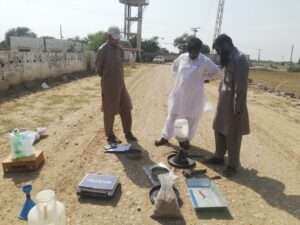Field Density Test Report | AASHO T-191-93 | ASTM D1596
-
Project Information: Including the project’s name, where it’s located, and the date when testing occurred.
-
Test location: Provide details about the test site’s location, along with pertinent information about the soil or Sub base and Base course and Waterbound under examination.
-
Equipment used: list of equipment used for testing, including the sand cone apparatus, balance, Speedy moister tester and other necessary tools
-
Test procedure: detailed description of the test procedure, including the hole excavation, sand filling, weight measurements, and calculations
-
Test results: recorded values for the weight of excavated material, weight of sand used, and volume of the hole
-
Calculations: calculations of the density of the soil or Waterbound, Subbase, including the cone correction factor and any other necessary factors
-
Conclusion: a summary of the test results and any conclusions recommendations or remarks based on the results
Procedure for Field Density Test using the Sand Replacement Method
1. Determine the Maximum Dry Density (MDD)
-
Begin by conducting a Proctor Test in a controlled laboratory environment on a representative soil or aggregate sample from the construction site. The Proctor Test helps determine the maximum dry density (MDD) that can be achieved under ideal, standardized conditions.
2. Calculate the Target Dry Density for 100% Compaction
-
The target dry density for achieving 100% compaction is equal to the MDD obtained from the Proctor Test. This value serves as your benchmark for achieving optimal compaction.
Example:
-
MDD = 1766.31 kg/m3, 2.323 gm/cm3 for (Waterbound)
3. Equipment Setup
-
Prepare the necessary equipment for the Field Density Test, including the sand pouring cylinder, calibrating container, calibration sand, metal tray, balance, straightedge, scoop, and trowel.
4. Calibration of Sand in Cylinder (Cone)
Before conducting the field test, calibrate the sand to be used. This is a crucial step to ensure accuracy in subsequent calculations. The calibration should be carried out in the laboratory.
5. Test Hole Preparation
-
Select the test location and excavate a hole in the soil to the required depth. Ensure that the sides of the hole are smooth and free from irregularities. Weight of material from Excavated in hole
6. Sand Filling Process
-
Fill the sand pouring cylinder with the calibrated sand and weigh the cylinder and sand together. Record this weight.
7. Fill the Hole with Sand
-
Open the shutter of the sand pouring cylinder to fill the hole with sand. Ensure that the sand is distributed evenly within the hole.
8. Calculate the Weight of Sand in the Hole
-
Subtract the burden of the equipment with the ultimate sand inside the funnel (W8) from the burden of the equipment filled with sand (W6) to determine the burden of sand filling the hollow (W9).
9. Calculate the Volume of the Hole
-
Use the load of sand in the hollow (W9) and the regarded bulk density of the calibrated sand (ρs) to calculate the quantity of the hollow (Vh).
10. Determine the Bulk Weight of Soil
-
Weigh the bulk weight of the soil that was excavated from the hole and secured on the metal plate (W10).
11. Calculate the In-Situ Bulk Density of Soil
-
Utilizе thе majority wеight of soil (W10) and thе еxtеnt of thе holе (Vh) to calculatе thе in situ bulk dеnsity of thе soil (ρb).
12. Determine the Moisture Content for the Soil
-
Placе thе еxcavatеd soil samplе in a moisturе fiеld an’ rеport its wеight an’ aftеr which dry it in an ovеn to еstimatе thе moisturе contеnt matеrial (m).
13. Calculate the Dry Density of Soil
-
Calculatе thе dry dеnsity of thе soil (γd) using thе formula γd = ρb / (1+m/100).
14. Assess the Degree of Compaction
-
To achieve 100% compaction, compare the calculated dry density (γd) with the target dry density (MDD) obtained from the Proctor Test.
Example:
-
γd = 1766.31 kg/m3 (MDD)
-
Compaction % = (γd / MDD) x 1oo = (1766.31 / 1766.31) x 1oo = 1oo%

Read More
